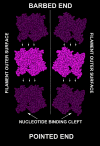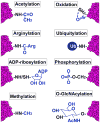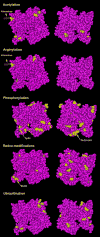Post-translational modification and regulation of actin
- PMID: 23195437
- PMCID: PMC3578039
- DOI: 10.1016/j.ceb.2012.10.009
Post-translational modification and regulation of actin
Abstract
Many of the best-studied actin regulatory proteins use non-covalent means to modulate the properties of actin. Yet, actin is also susceptible to covalent modifications of its amino acids. Recent work is increasingly revealing that actin processing and its covalent modifications regulate important cellular events. In addition, numerous pathogens express enzymes that specifically use actin as a substrate to regulate their hosts' cells. Actin post-translational alterations have been linked to different normal and disease processes and the effects associated with metabolic and environmental stressors. Herein, we highlight specific co-translational and post-translational modifications of actin and discuss the current understanding of the role that these modifications play in regulating actin.
Copyright © 2012 Elsevier Ltd. All rights reserved.
Figures



Similar articles
-
Crosstalk between Ubiquitination and Other Post-translational Protein Modifications in Plant Immunity.Plant Commun. 2020 Mar 25;1(4):100041. doi: 10.1016/j.xplc.2020.100041. eCollection 2020 Jul 13. Plant Commun. 2020. PMID: 33367245 Free PMC article. Review.
-
Actin Post-translational Modifications: The Cinderella of Cytoskeletal Control.Trends Biochem Sci. 2019 Jun;44(6):502-516. doi: 10.1016/j.tibs.2018.11.010. Epub 2019 Jan 2. Trends Biochem Sci. 2019. PMID: 30611609 Review.
-
Actin filaments-A target for redox regulation.Cytoskeleton (Hoboken). 2016 Oct;73(10):577-595. doi: 10.1002/cm.21315. Epub 2016 Aug 6. Cytoskeleton (Hoboken). 2016. PMID: 27309342 Free PMC article. Review.
-
Protein Modification and Autophagy Activation.Adv Exp Med Biol. 2019;1206:237-259. doi: 10.1007/978-981-15-0602-4_12. Adv Exp Med Biol. 2019. PMID: 31776989 Review.
-
Aberrant post-translational protein modifications in the pathogenesis of alcohol-induced liver injury.World J Gastroenterol. 2016 Jul 21;22(27):6192-200. doi: 10.3748/wjg.v22.i27.6192. World J Gastroenterol. 2016. PMID: 27468209 Free PMC article. Review.
Cited by
-
Mechanisms of actin disassembly and turnover.J Cell Biol. 2023 Dec 4;222(12):e202309021. doi: 10.1083/jcb.202309021. Epub 2023 Nov 10. J Cell Biol. 2023. PMID: 37948068 Free PMC article. Review.
-
Manganese superoxide dismutase promotes interaction of actin, S100A4 and Talin, and enhances rat gastric tumor cell invasion.J Clin Biochem Nutr. 2015 Jul;57(1):13-20. doi: 10.3164/jcbn.14-146. Epub 2015 May 22. J Clin Biochem Nutr. 2015. PMID: 26236095 Free PMC article.
-
Diversity from similarity: cellular strategies for assigning particular identities to actin filaments and networks.Open Biol. 2020 Sep;10(9):200157. doi: 10.1098/rsob.200157. Epub 2020 Sep 2. Open Biol. 2020. PMID: 32873155 Free PMC article.
-
Structural insights into actin isoforms.Elife. 2023 Feb 15;12:e82015. doi: 10.7554/eLife.82015. Elife. 2023. PMID: 36790143 Free PMC article.
-
Rapid and dynamic arginylation of the leading edge β-actin is required for cell migration.Traffic. 2018 Apr;19(4):263-272. doi: 10.1111/tra.12551. Epub 2018 Mar 8. Traffic. 2018. PMID: 29384244 Free PMC article.
References
Publication types
MeSH terms
Substances
Grants and funding
LinkOut - more resources
Full Text Sources
Other Literature Sources

